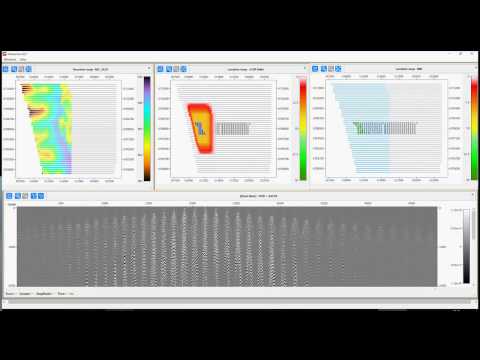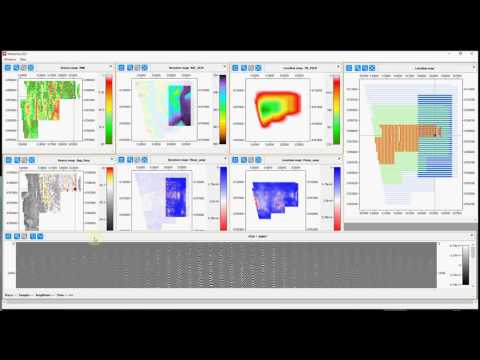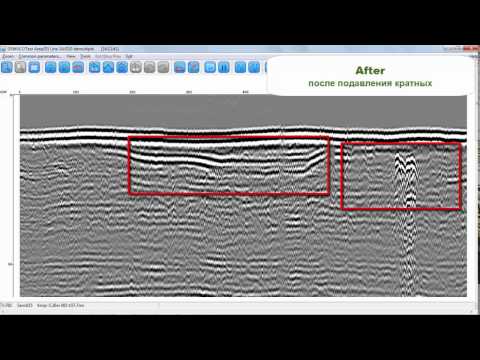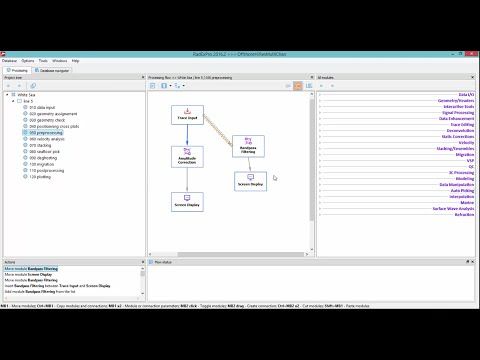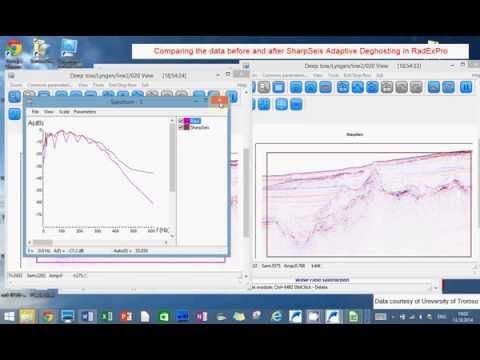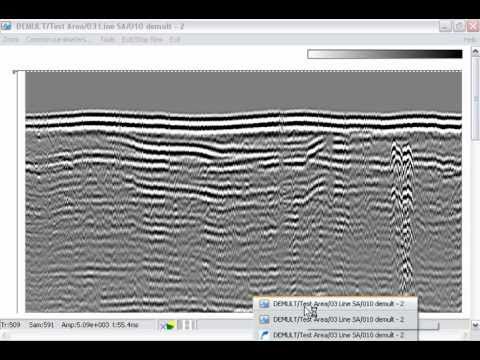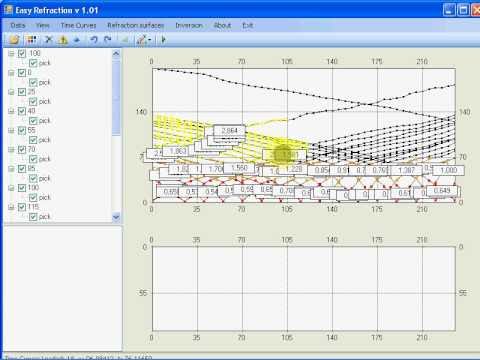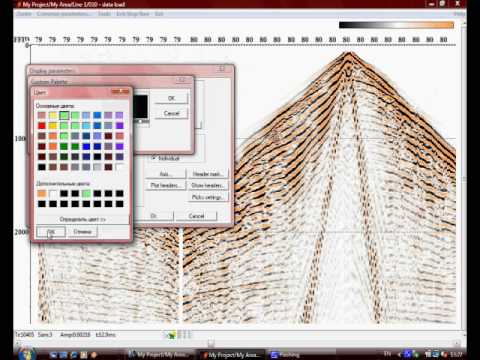RadExPro
RadExPro is flexible, state-of-art processing package, suitable for HR/UHR marine data processing, land shallow seismic data processing (refraction, reflection, MASW and VSP), as well as large-scale data QC, including Real-Time and fast-track processing.
Near-surface land data processingRadExPro is fully capable for shallow structure imaging of both 2D and 3D land seismic reflection surveys with any type of source – sledgehammer, weight drop, guns, vibroseis and others.
Set of available algorithms includes refraction statics computation; crooked line CDP binning; linear and random noise attenuation algorithm’s, including 3D filters; SCAC; deconvolutions; auto statics routines; interactive velocity analysis; horizon-based velocity analysis; pre/post stack migrations.
Seismic refraction surveys are widely used for shallow seismic engineering applications. Time-delay and GRM (General Reciprocal Method) methods are implemented in RadExPro.
RadExPro provides fast and convenient automatic first break picking tool of seismic gathers to be used for further refraction analysis. All results are stored in the database and can be quickly accessed. Refraction horizons building process is fully interactive, which allows one to control the entire process from the very beginning up to the final image. This results in avoiding pitfalls during the processing and building the most relevant subsurface structure.

Multichannel analysis of surface waves utilizes Rayleigh wave dispersion properties to build Vs (shear wave) velocity profile up to 30 m depth for various geotechnical purposes. Ground roll strength on typical sledgehammer seismic record allows one to use its energy for MASW. General procedure for MASW processing includes dispersion curve calculation, fundamental and higher modes picking, followed by inversion. RadExPro has a dedicated MASW routine with user-friendly interface, which allows to perform all steps in a row up to final Vs section.
Engineering VSP surveys
VSP and crosshole data processing requires efficient and sophisticated processing flow. RadExPro seismic software provides all necessary algorithms for multi-component data processing – hodogram analysis, 2C/3C component orientation, wavefield separation, velocity modelling, corridor stacking and well tie to reflection seismic data.
High-resolution marine seismic processingRadExPro has a complete set of algorithms for shallow marine seismic data processing, including modern denoising algorithms, static corrections, de-signature techniques (debubbling, adaptive deghosting, signal shaping), multiple removal (SRME), adaptive subtraction, 3D regularization, pre-stack migrations (PSTKM). Many routines are specially developed and adapted to high resolution data processing.
Large-scale seismic surveysData QC
Infield data quality control is a standard procedure during oil and gas acquisitions, which typically includes position data quality checks, seismic data quality control and their relationship. RadExPro has various instruments, including data and spectrum analysis in user-defined windows, attribute analysis as well as modern interactive displays to provide the full control during the survey.
Real-Time data QCReal-Time Data Quality Control ensures that all acquired data are in the client’s specification. RadExPro has a unique system of reading data files, as soon, as they come to the server and feeding them into the QC flows, resulting in immediate display on each QC plot, without any delay. The set of QC is fully adjustable and can be constructed, based to the specifics of the particular survey and client’s requests. End of line reports with the QC maps are also available. Typical set of quality control products includes:
Source quality control – near-filed hydrophones check, bubble peak amplitude, primary-to-bubble ratio.
Data quality control – shot gathers, near-trace gathers, amplitude analysis, spectral analysis, channel maps, brute stack, etc.
Fast-track and in-field processing are typically performed as a part of data quality control routine and for quick evaluation of the seismic image. Often this type of processing runs parallel to the acquisition, i.e. on the seismic vessels. Replication and parallelization allow processors to compute high performance tasks after completion of each block or sail line and provide results to the client promptly.
| Start | Professional / Real-Time | |
|
I / O |
||
| Input data from SEG-Y, SEG-2, SEG-B, SEG-1, SCS-3 files, with optional header | + | + |
| Input data from SEG-D and FairFieldNodal Receiver Gather files, with with optional header |
|
+ |
| Input GPR data from LOGIS, Zond, RAMAC/GPR, GSSI, Pulse EKKO formats | + | |
| Input of data from a file in an arbitrary demultiplexed format, including information in the trace headers | + | + |
| Reading data from tape drives | + | + |
| Output of data to SEG-Y files with the ability to redefine the headers | + | + |
| Outputting data to an ASCII text file | + | + |
| Assigning geometry | ||
| Import from ASCII table files | + | + |
| Download from SPS and UKOOA files P1-90 | + | |
| Calculation using mathematical formulas | + | + |
| Display and editing in a spreadsheet view | + | + |
| Special interactive module for entering geometry into shallow data | + | + |
| Special module for entering marine geometry | + | + |
| Special input module for geometry VSP | + | |
| 2D and 3D bination along an arbitrary curvilinear profile | + | |
| Statics | ||
| Calculation of static corrections for relief | + | + |
| Calculation of residual static corrections for surface conditions | + | |
| Calculation of static corrections by the Maximum Power method | + | |
| Calculation of correlation static corrections | + | + |
| Applying static corrections | + | + |
| Working with amplitudes | ||
| Amplitude correction: linear (for spherical divergence), exponential, AGC, path balancing, time-varying amplification | + | + |
| AGC removal | + | + |
| Alignment of amplitudes between ensembles | + | + |
| Elimination of the constant component | + | + |
| Deconvolution and editing the shape of the spectra | ||
| Deterministic | + | + |
| Null-phase | + | + |
| Predicting | + | + |
| Whitening | + | + |
| Surface-matched | + | |
| Nonstationary predictive | + | |
| F-X predictive filtration (F-X deconvolution) | + | |
| Isolation of the zero-phase pulse | + | |
| Spectral factorization of Kolmogorov | + | |
| Spectral whitening | + | + |
| Changing the spectrum shape | + | |
| Exponentiation of the F-K / F-X amplitude spectrum | + | |
| Multicomponent processing | ||
| Analysis of hodograms | + | |
| Rotation of 2 or 3 components | + | |
| Rotating multi-component data FairFieldNodal | + | |
| Interpolation | ||
| Interpolation of traces along the profile to a regular step | + | + |
| Interpolation of the profile system to a regular grid (pseudo-cube calculation) | + | |
| 3D F-Kx-Ky regularization | + | |
| Working with headers | ||
| Math operations over header fields | + | + |
| Spreadsheet Editor | + | + |
| Import from ASCII files, export to ASCII files | + | + |
| Averaging in a sliding window | + | + |
| Shifting header field values to a specified number of traces | + | + |
| Input and output of kinematic corrections to the value in the header | + | + |
| Surface-consistent linkage of the heading header value (eg static shifts or amplitudes) | + | |
| Displaying header field values as graphs | + | + |
| Analysis of values on related cross-spacing and histograms | + | |
| Combining Data Sets | ||
| Subtraction / addition of two sets of data | + | + |
| Vertical integration of two data sets along the horizon | + | |
| Filtering and operations on the routes | ||
| Frequency Filtering: | ||
| strip filtering with a simple trapezoidal filter | + | + |
| Ormsby filter | + | + |
| Butterworth filter | + | + |
| band-stop filter | + | + |
| Two-dimensional filtering | + | + |
| F-K filtration | + | + |
| F-X predictive filtration (F-X deconvolution) | + | |
| 3D F-X-Y deconvolution | + | |
| Radon Transformation | + | |
| Calculation of the amplitude spectrum | + | + |
| Calculation of the phase spectrum | + | + |
| Calculation of autocorrelation and cross-correlation functions | + | + |
| Logarithm and Exponentiation | + | + |
| Adaptive subtraction of wave fields | + | |
| Convolution | + | + |
| Arithmetic operations trace / trace and trace / scalar | + | + |
| Raising the route to the power | + | |
| Conversion to radial routes (direct and reverse) | + | + |
| Suppression of local high-amplitude interference ("emissions") | + | + |
| Frequency-domain noise reduction (TFD noise attenuation) | + | |
| Noise reduction in the frequency-time domain (manual) | + | |
| Edit traces | ||
| Resampling traces | + | + |
| Elimination of unwanted traces | + | + |
| Zeroing of trace sections (muting) | + | + |
| Polarity reversal | + | + |
| Changing the length of the route | + | + |
| Time-to-depth conversion | ||
| Translation of data from the time scale to the in-depth and vice versa using different speed laws | + | + |
| Migration and DMO | ||
| 2D/3D Kirchhoff time migration before and after summation | + | |
| F-K migration Stolta | + | + |
| Three-dimensional F-K migration Stolta | + | |
| T-K migration | + | + |
| 2D F-K DMO | + | |
| QC and attribute analysis | ||
| Quality control of seismograms OPV / OPP: calculation of mean and rms amplitude, signal-to-noise ratio, resolution, and visible frequency in rectangular or shaped space-time window | + | |
| Quality control of seismograms OPV / OPP: calculation of mean and rms amplitude, signal-to-noise ratio, resolution, and visible frequency in rectangular or shaped space-time window | + | |
| Calculation of the multiplicity and distribution of deletions | + | |
| Observation system maps, multiplicities, distribution of deletions | + | |
| Analysis of the relationship between header fields using crossplots and histograms | + | |
| Mapping of attributes with a cartographic substrate | + | |
| The estimation of the average amplitude in the window, the rms amplitudes in the window, the maximum value of the amplitude, the minimum value of the amplitude, the maximum absolute value of the amplitude | + | |
| Determination of the time corresponding to the maximum, minimum, maximum absolute amplitude value | + | |
| Determination of the dominant and apparent frequency, centroid frequency, width spectrum on the total section in the window along the horizon | + | |
| Determination of the signal-to-noise ratio on the total section in the window along horizon | + | |
| Calculation of ACF and FVK | + | |
| Interactive determination of the velocities of all types of waves | + | + |
| Calculation of instantaneous frequency, amplitude and phase | + | |
| Interactive maps of attributes | + | |
| Velocities and summation of CDP | ||
| Binning of 3D data on common midpoints | + | |
| 2D binning along CDP along an arbitrary curvilinear profile | + | |
| Formation of OGT seismograms | + | + |
| Formation of superseismograms | + | + |
| Recalculations of speed laws | + | |
| Interactive analysis of CDG summation rates | + | + |
| Pororizontal velocity analysis | + | |
| Calculation and input of kinematic corrections | + | + |
| Summation of CDP | + | + |
| Processing of marine data | ||
| Entering Geometry in Marine Data | + | + |
| Importing geometry from UKOOA files P1-90 | + | |
| Correction of casual and missed shots | + | + |
|
Importing static corrections for tides |
+ | |
| Calculation of static corrections for marine seismoacoustics | + | |
| Suppression of repeated pulsation of the bladder | + | |
| Suppression of multiple waves using 2D SRME technology | + | |
| Suppression of multiple seismic acoustics with small deletions on data | + | |
| SharpSeis™ adaptive satellite-wave suppression / broadband processing | + | |
| MPW | ||
| The processing of travel curves of refracted waves by the method of MPW (t0 and GRM) | + | + |
| Processing of the first arrivals of refracted waves | + | + |
| Surface wave analysis | ||
| The construction of the model of transverse wave velocities of the upper part of the section by means of a multichannel surface wave analysis (MASW) | + | + |
| Vibroseis | ||
| Correlation | + | + |
| VSP | ||
| Entering geometry and inclinometry in VSP data | + | |
| Analysis of hodograms, 2C and 3C rotation | + | |
| Separation of wave fields | + | |
| Calculation of the arrival time of a direct or reflected wave from a given horizon for a horizontal-layered model | + | |
| Construction of a layered velocity model | + | |
| Calculation of the arrival time of a direct or reflected wave from a given reflecting boundary for a horizontal layered medium | + | |
| Kinematic corrections of non-longitudinal VSP | + | |
| Import logging data, import and export speed models | + | |
| Loading and unloading speed models, logging data | + | |
| Joint interpretation of VSP, GIS, seismic data | + | |
| Kirchhoff migration of VSP seismograms | + | |
| VSP-OGT transformation | + | |
| Visualization and printing | ||
| Data visualization by various methods | + | + |
| The display of traces by the method of deviations over the velocity or data field, derived by the variable density method | + | + |
| View and compare multiple profiles at once | + | + |
| Synchronization of scales, scroll bars and amplification between several windows for convenient data comparison | + | + |
| Interactive calculation of the amplitude spectrum of any data fragment | + | + |
| Displaying multiple spectra in one window | + | + |
| Visualizing header field values | + | + |
| Display profiles, attributes, horizons, etc. on the map | + | + |
| Visualization of a seismic section along an arbitrary line from a map | + | + |
| Adding linear objects to cuts in three-dimensional space | + | + |
| Export of a cross-raft, histograms of header fields to a bitmap image | + | |
| Print processing results with preview | + | + |
| 3D visualization | ||
| 3D Cube Visualization | + | |
| Data and stream management | ||
| Processing in the framework of projects. Projects are easily migrated with all data and parameters | + | + |
| Ability to work with several projects simultaneously | + | + |
| Create queues for processing threads for parallel execution | + | + |
| Copying processing threads with all procedures and parameters | + | + |
| Export / import processing flows between projects | + | + |
| Processing history | + | + |
| Running a set of processing routines with different parameters to compare results | + | + |
| Rearrange data during processing | + | + |
| Fast re-sorting of large amounts of data in the process | + | |
| Combining multiple threads into a queue, concurrent execution bursts | + | |
| Batch processing of the file list in one thread | + | |
| Interpolation / extrapolation of horizons | + | |
| Interpretation | ||
| Tracking reflections in manual and automatic modes | + | + |
| Building a grid on the impaled horizons or attributes | + | + |
| Calculation of attributes along horizons | + | |
| Simultaneous analysis and comparison of different types of data to the map and in three-dimensional space | + | |
